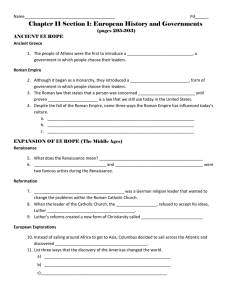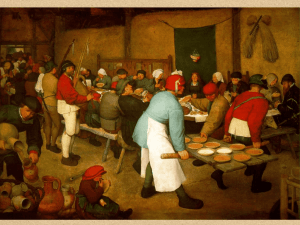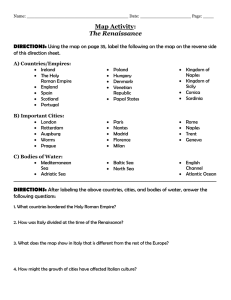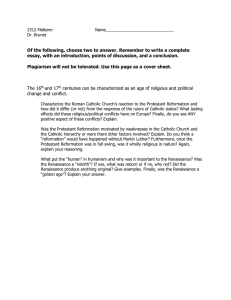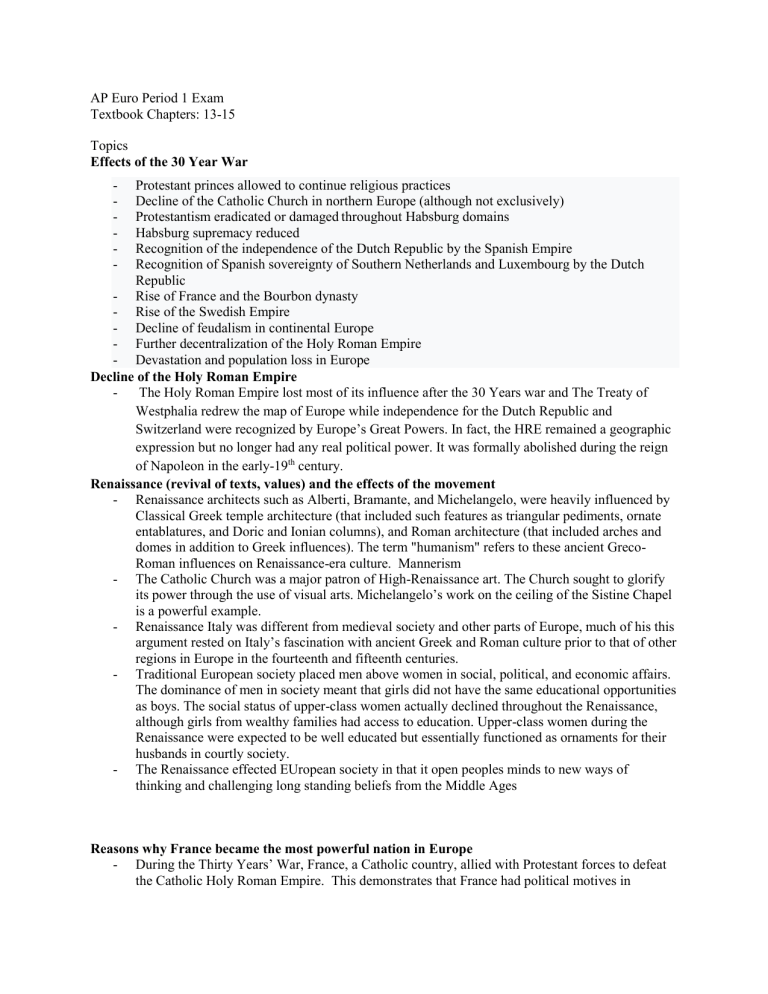
AP Euro Period 1 Exam Textbook Chapters: 13-15 Topics Effects of the 30 Year War - Protestant princes allowed to continue religious practices Decline of the Catholic Church in northern Europe (although not exclusively) Protestantism eradicated or damaged throughout Habsburg domains Habsburg supremacy reduced Recognition of the independence of the Dutch Republic by the Spanish Empire Recognition of Spanish sovereignty of Southern Netherlands and Luxembourg by the Dutch Republic - Rise of France and the Bourbon dynasty - Rise of the Swedish Empire - Decline of feudalism in continental Europe - Further decentralization of the Holy Roman Empire - Devastation and population loss in Europe Decline of the Holy Roman Empire The Holy Roman Empire lost most of its influence after the 30 Years war and The Treaty of Westphalia redrew the map of Europe while independence for the Dutch Republic and Switzerland were recognized by Europe’s Great Powers. In fact, the HRE remained a geographic expression but no longer had any real political power. It was formally abolished during the reign of Napoleon in the early-19th century. Renaissance (revival of texts, values) and the effects of the movement - Renaissance architects such as Alberti, Bramante, and Michelangelo, were heavily influenced by Classical Greek temple architecture (that included such features as triangular pediments, ornate entablatures, and Doric and Ionian columns), and Roman architecture (that included arches and domes in addition to Greek influences). The term "humanism" refers to these ancient GrecoRoman influences on Renaissance-era culture. Mannerism - The Catholic Church was a major patron of High-Renaissance art. The Church sought to glorify its power through the use of visual arts. Michelangelo’s work on the ceiling of the Sistine Chapel is a powerful example. - Renaissance Italy was different from medieval society and other parts of Europe, much of his this argument rested on Italy’s fascination with ancient Greek and Roman culture prior to that of other regions in Europe in the fourteenth and fifteenth centuries. - Traditional European society placed men above women in social, political, and economic affairs. The dominance of men in society meant that girls did not have the same educational opportunities as boys. The social status of upper-class women actually declined throughout the Renaissance, although girls from wealthy families had access to education. Upper-class women during the Renaissance were expected to be well educated but essentially functioned as ornaments for their husbands in courtly society. - The Renaissance effected EUropean society in that it open peoples minds to new ways of thinking and challenging long standing beliefs from the Middle Ages Reasons why France became the most powerful nation in Europe - During the Thirty Years’ War, France, a Catholic country, allied with Protestant forces to defeat the Catholic Holy Roman Empire. This demonstrates that France had political motives in - keeping Germany weak and divided, even if it meant that Catholic unity would not be achieved with the HRE’s loss. France feared that a unified HRE (i.e. a unified Germany) would pose grave security risks on the eastern French border. With the Holy Roman Empire irreparably weakened, France emerged as the dominant military force in Europe by the mid-17th century. Under the reign of Louis XIV (1648-1715) France would achieve frightening power Descartes- Directly from Notes Bacon- Directly from Notes Copernicus- Directly from Notes Ferdinand and Isabella - Powerful Catholic King and Queen of Spain who looked to expand the wealth of Spain through Exploration - Unlike Portugal and the Netherlands who established strong trade routes and trade stations in Asia during the 16th and 17th centuries, Spain’s major colonial energies were directed at the New World. Although Spain gained the Philippines in the 16th century, it gained little else in Asia. - Spanish explorers and conquistadors who often treated the American Indian population with cruelty. By 1600, approximately 90% of the indigenous peoples of the New World had been wiped out, mostly due to disease, although many died as result of European barbarity. - Better and more accurate maps (cartography) enabled explorers to expand their expeditions to new regions as well as improve navigation on established trade routes. Charles V - Charles V ruled the Holy Roman Empire and sought to restore Catholic unity in western and central Europe. - Excommunicated Martin Luther at the Diet of Worms William of Orange - Prince William of Orange (“the Silent”) led the 17 provinces of the Netherlands during their fight for independence from Spain. - He would help the Northern 7 Provinces remain Protestant and the lower 10 would remain Catholic - Would later be asked by the parliament of England after their civil war to rule along side his wife Mary as new Constitutional Monarchs Oliver Cromwell - Military dictator who would take over leadership of England as a military dictator after the English Civil War Martin Luther - Martin Luther’s criticism in his 95 Theses of the Catholic Church’s selling of indulgences opened the door to further scathing attacks on the perceived corruption of the Church. - Luther’s teachings encouraged spiritual equality which many peasants interpreted as a reason to revolt from their feudal lords. Luther, however, believed people were bound to obey their secular rulers and he supported the violent suppression of the German Peasant Revolts John Calvin - Student of Luther who branched out to create his own form of Protestantism that would be named for him. - Believed in the ideas of “Predestination”- the idea that the second we are born God makes a choice as to our salvation or damnation and there is nothing that can be done about it - French Protestants (Huguenots) were most directly influenced by Calvinism and the ideas of John Calvin. Zwingli - Huldrych Zwingli or Ulrich Zwingli was a leader of the Reformation in Switzerland, born during a time of emerging Swiss patriotism and increasing criticism of the Swiss mercenary system. He attended the University of Vienna and the University of Basel, a scholarly center of Renaissance humanism Phillip II - Leader of Spain and one time husband to Mary Tudor (Queen of England) - Sent the Spanish Armada in 1588 against his once sister-in-law Elizabeth I in a show a power as well as his hope as a Catholic monarch to try and invade bring England back to the Catholic faith - Phillip II of Spain would have been most likely to endorse the actions of the French monarchy (and in fact did give aid to the Valois monarchy) because he wanted to keep Catholicism dominant across the continent. Elizabeth I - Daughter of Henry VIII. - Would settle the question of religion in England through the Act of Uniformity declaring the Anglican Church to be the official church of England - Would defeat and turn back Phillip II attack of the Spanish Armada Humanism - A Renaissance ideal that stated the belief in a humans potential to achieve anything they wish through work to be the best version of themselves. Civic Humanism - form of classical republicanism that involves the fusion of participatory political engagement with classical learning as revived in the Renaissance - involves a commitment to the active political life under the influence of classical models Diet of Worms - A meeting in the town of Worms in Germany where Martin Luther was placed on trial and questioned for his beliefs that he outlined in his 95 Theses. The Pope and Holy Roman Emperor Charles V tried to use this meeting to give Luther a chance to take back his beliefs and fall back in line with the Catholic church, which he refused to do. Council of Trent - The Council of Trent (1545-1563) began the process of reforming the Catholic Church in the face of criticisms from both within the Church and from Protestants. While Catholic doctrine remained unchanged, some of its practices such as the selling of indulgences, simony, and nepotism, were curtailed. - The Council of Trent represented the cornerstone of the Catholic Counter Reformation. The Jesuits and Ursuline were new Catholic orders during the Counter Reformation era. Catholic tradition emphasized architectural grandeur to glorify God and the Church’s power Protestant Reformation - Luther’s Protestant Reformation resulted in the shattering of religious unity in Europe. Within a few years, most northern German states adopted Lutheranism and removed Catholic officials from their realms. New Protestant off-shoots, such as Calvinism, further divided western and central Europe religiously and politically. These divisions ultimately resulted in the fracturing of the Holy Roman Empire. - The German Reformation under Luther stressed education for girls as they would grow up to be mothers who could teach their children to read the Bible. Schools for girls were built throughout Germany in the sixteenth century and as Protestantism spread throughout Europe, so did the emphasis on literacy. Edict of Nantes - The Edict of Nantes was issued after the French Wars of Religion by Henry IV - The Edict of Nantes was successful in easing religious tensions in France by allowing Huguenots the right to practice in their own fortified towns William Harvey - Doctor during the Scientific Revolution credited with the discovery that the human heart works as a pump within the body Vesalius - Anatomist during the Scientific Revolution credited with updating the medical fields knowledge of the inner workings of the human body through dissection and meticulous drawing of body parts Hapsburg-Valois Wars HRE VS France - The Habsburg-Valois Wars between the Holy Roman Empire and France were fought between the two ruling dynasties for continental dominance. Issue between monarchy and church and monarchy and upper class - Tensions increased between monarchs and their subjects as a result of new political philosophies that called for a stronger monarchy, an increase in the number of gentry in urban areas, and nobles who wished to retain local control and privilege. Scientific Method and its effects - The Scientific Revolution of the seventeenth century led many people to question traditional beliefs and traditions leading to an overall decrease in witchcraft accusations by the end of the century. - During this time the Scientific Method was developed as a way to test hypothesis and create conclusions based on collected data - The Scientific Method would be used in new areas of physical Science to explain phenomenon in nature as well as later be applied to the study of society and people during the Enlightenment

